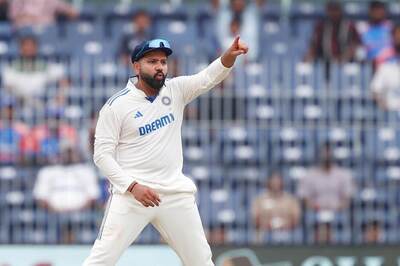
views
As the budget date nears, numerous columns are being written to set expectations from it. In most cases, this exercise is one of regression to the mean – driven by past budget announcements. So instead of writing a column to outline realistic expectations from the budget of this year, I will focus on a dream budget for India of 2016. I will highlight those broad budget announcements that would keep India firmly on the path to equitable growth over next hundred years. In my view of things, this works as a canonical model against which we can compare and contrast our nasty and brutish reality, with apologies to Hobbes.
As is the annual ritual, when the budget speech of the FM starts, most TV channels will begin to track the stock market. This is done with an aim to capturing the announcement effects from the speech. Yet, it also reflects the gross mistake experts make in believing the Sensex to be reflective of the Indian economy. There is fundamental distinction between the Economy, the financial markets and the Sensex. The movement of the stock market captures a very small subset of the Indian financial markets and an even smaller subset of the Indian economy. So first, we need to correct the context within which the Union budget of the Government of India is announced.
Here are some first best pronouncements that the FM could make to pull the Indian economy back on the trajectory set by the general elections of 2014.
1. Banking reforms which bring about fundamental structural changes within the sector. Let some of the very sick public sector banks, currently expecting life support, quickly succumb. This is in the long term interest of the health of our economy. In the short run, saving these badly run banks will affect most new schemes which are aimed at kick-starting an entrepreneurial revolution within India. The contagion of bad loans never disappear, they will loom large as massive defaults from schemes like StartUp India, Skill India and such. That is because saving inefficient financial institutions will have the repercussion of destroying the culture of financial discipline that takes generations to build in any economy.
2. Health reforms that will not only raise the overall health spending in the country, but significantly realign the expenditures such that the government spends approximately 70% of resources on primary care and the remaining on secondary and tertiary care. Mis-management and poor governance are key to explaining the difference between states that have innovated and used their NHM budget efficiently with those that have not. Creating space for more autonomous corporations for drug procurement and delivery of care would be most helpful. On the financing front, we are putting too much emphasis on health insurance, at the expense of trying other instruments. Over-reliance on insurance has proven to be a disaster for the US healthcare system. One innovative solution could be the medical savings accounts. Several countries are experimenting with this with positive outcomes. On the shortage of doctors and other HR concerns, the government can begin by dismantling the corrupt MCI and creating a new institution based on global best practices and transparency.
3. Reforms in the higher education sector is fundamental if India is to realize its ambition of becoming a “Human resource capital of the world”. We would have nearly succeeded in our mission if by “HR capital” we mean a factory supplier of engineers and doctors to the world. According to a World Bank analysis, India has fewer R&D professionals per million people than many other nations. India has 160, as compared to 710 in Brazil, 890 in China, 3,838 in the United States, 3,950 in Germany, and 5,151 in Japan. For India to genuinely become the HR capital of the world, (i) we have to become the suppliers of ideas and innovations and (ii) we have to figure out how to retain our best brains in this country. For this, we need strong autonomous regulatory bodies across the country with adequate capacity. UGC needs to be replaced or seriously reconfigured with several regional UGCs with the capacity to do the regulatory due diligence to promote research and high quality teaching in colleges and universities.
4. To tackle the growing agrarian distress, the budget must look into a few critical measures. India needs to have a robust crop insurance policy but it is also important to learn from the mistakes of many countries before us. Global data shows that simple crop insurance is very likely to fail due to acute problems of adverse selection, moral hazard, high transactions cost and weak enforcement of contracts. The data on state supported crop insurance programs finds that costs exceeded revenues by 4.6 times in both Brazil and Japan, 3.7 times in Mexico and 2.4 times in United States. The question is: can India do better? The answer is: Yes, if we index crop insurance to weather or rainfall which is easily measured and which therefore eliminates the basic risks. Beyond insurance, it is fundamental that we lay down the foundations for sustainable agricultural growth in the future. Institutions that connect farmers to markets – for both inputs and selling outputs- need to be encouraged. Besides these, the government must prioritize investments into rural infrastructure. Better connectivity can significantly lower cost and risks within the agriculture sector. The case of farmer suicides needs attention, though it has been improving over last 5 years. The policy interventions, however, need to move beyond debt. Research has shown that health concerns are a leading cause, therefore prioritizing rural health infrastructure can be a long term solution.
5. Skilling as a mission is important, particularly given the poor performance of our education system. Despite high enrolment, the quality of our students has been deteriorating over last several years. To plug the gap in skill, the government launched the Skill India mission. Now, it is important to note that just because an idea worked in a standardised sector like IT (with the experience and leadership of TCS), it cannot be transplanted across all other sectors of the economy. This is too top down an agenda and requires a grand impossible design that matches supply and demand throughout the economy. The lessons from the long struggle and failures of NSDC must be to make skilling more bottoms up. Let us incentivise employment creation. Let us experiment with apprenticeship, such that students learn on the shop floor and become more employable in the market.
6. Setting up of the Third Administrative Reforms Commission with a hard deadline of 6 months to make recommendations. Members of this Commission must mostly include people from outside of the bureaucracy, serving or retired, to avoid conflict of interest. Setting up of this commission and a quick and thorough implementation of the recommendations are fundamental to realizing India’s potential. The government needs to scrape off the plaque build-up in its arteries for fresh blood to flow and keep young India’s heart racing.
It is highly unlikely that the FM will make any of the above announcements. But what’s an economist who cannot dream of a first best scenario?
(Author Dr. Shamika Ravi is Fellow, Brookings India, and an economist. The views in the article are personal, not that of CNN-IBN/IBNLive)




















Comments
0 comment